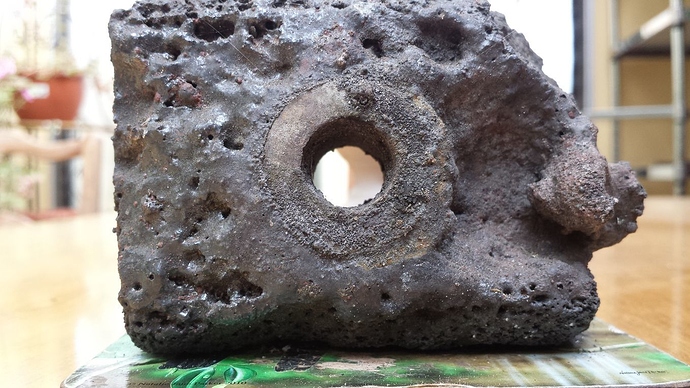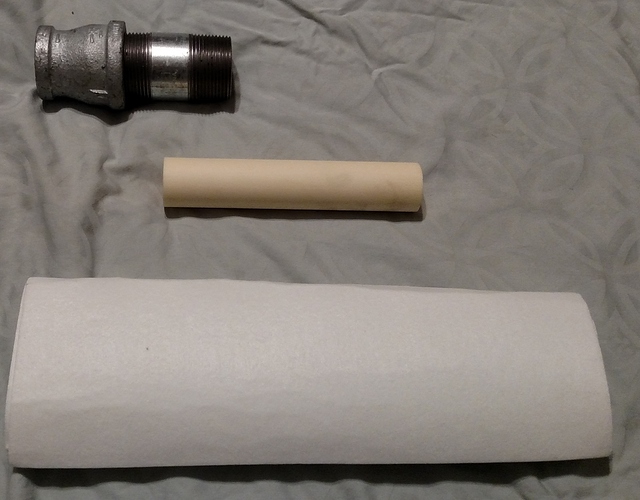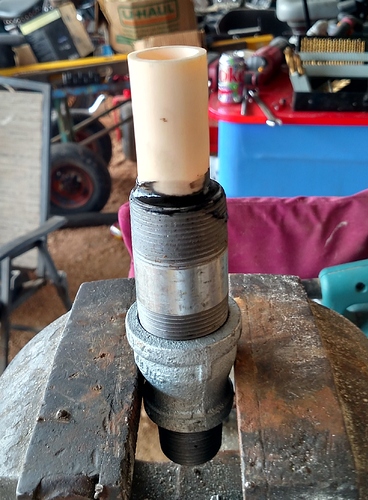oops I said titanium when i meant tungsten as a protective shield for the thermocouple. Big difference!
Bruce - Have you ever tried any tungsten inside the gasifier (everybody else welcome to chime in on this). It looks like all the other metals have been found lacking. Even though tungsten has a high melting temperature, I wonder if it would still be subject to the corrosion / oxidation problems we see with other metals?
Screen Shaker Test
Tested the screen shaker last night. Looks like it is going to work OK. But I don’t need nearly that steep of an angle. It needs to be almost flat (maybe around 5-10 degrees slope).
Maybe slide the “training wheels” up until they’re almost brushing the edge of the box they’re on?
Hi Kyle , as mentioned in the past I have run Tungsten carbide as a nozzle , it was last year and a lot of water under the bridge since , and so the actual running hours have faded from memory , if I hazard a guess I would say the pictures show the nozzle after maybe 30 hours run time .
This is a soft type kiln brick that was bored out so as to allow the tungsten nozzle to sit inside with a nice tight fit , the kiln brick as mentioned before starts to turn to glass , and a little bit of a build up on the tungsten itself , but that build up just scrapped off easy , notice the top left hand side where I removed the build up on the face its as good as new underneath .
Dave, where did you ever source a tungsten nozzle!?!
I was thinking of ordering a bunch of 10 mm wide 5/8" jewelry rings in tungsten and casting them into refractive will try the titanium first then a few other ideas… If I ever get out there… a very busy spring.
David Baillie
David I picked this piece up on a visit back home to the UK .
My brother has a customer that allowed him to have a look through there scrap bin and this is what he found .
Was fun bringing it back through airport security though as it shows up on xray as something dense and heavy and very black on there screen .
Dave
Dave - Sorry. Didn’t mean to make you repeat yourself. I guess I missed your previous post about using tungsten carbide, or it had slipped my mind.
Anyway, I was interested in trying pure tungsten (a metal) versus tungsten carbide (an interstitial compound of tungsten and carbon, typically alloyed with cobalt in tooling applications).
Don’t really know which would be better or worse.
Looks like your soft firebrick was holding up fairly well, along with the tungsten carbide tube.
What made you change to your current design?
David - These guys claim to have “tungsten sleeves” maybe as a stock part?
I haven’t contacted them, since that first quote I got from another supplier scared me silly.
But that was for a custom pipe.
Maybe these guys have something lying around that would work???
http://www.rembar.com/Industry.html?gclid=CJHSg-WJnMwCFYE8gQod5u4PIQ
I got a few of my things in from Amazon today.
Here is a picture of the parts I was thinking about using to make a nozzle out of an alumina ceramic tube.
At the top is a 1 inch to 1 1/4 inch coupling with a 1 1/4 inch nipple installed.
The middle is the Alumina tube.
The bottom is some thin (1/16") ceramic blanket.
My idea was to wrap the tube in the ceramic blanket then stuff it down in the 1 1/4" tube.
That would leave a couple of inches of “naked” alumina tube protruding.
It occurs to me that (whatever kind of nozzle you have) most of the trouble happens where the air, the nozzle, and the charcoal, are all super-close, to the point that they are physically touching.
I don’t know if that is true or not.
But it would explain a few things.
Hi Kyle , sorry mate I didn’t mean it to come across as if I was being a smart arse , was only making a point in case anyone thought I was repeating myself to often as I had mentioned this nozzle on other posts in the past .
Anyway I would have to make a call to the UK but I think that this nozzle is made from pure Tungsten and does not have carbide in it , my brother would know for sure as he was the one that took it from the scrap sintering bin .
The reason I moved onto alumina tubes and then TIG nozzles was just because I needed to try other hole sizes as the tungsten has a hole dia of only 12mm and i wanted to try 20 and 25 mm dia holes , only because I run a number of various size engines I wanted a 1 fits all size if possible .
Unless I could get tungsten for the same price of the TIG nozzles I wouldn’t bother changing now , as I am very happy with the way they work .
Your idea of shielding that alumina tube is the only way to go , I covered nearly all but the last inch to protect my last one as the other 3 broke to easily uncovered and when the 4th and last one broke is when I moved onto tig nozzles .
Dave
Dave - No worries 
I have benefited a lot from the knowledge you have freely shared on this forum, and I really appreciate it.
I imagine that I am headed to the same nozzle design you are using.
You have been there / done that, and you have found something that works.
But, since I have got this stuff, and am waiting on my TIG nozzles and refractory cement, I imagine I will give this a whirl just to see what happens.
The only design that I haven’t heard anyone else mention trying is the “gas blanket” design I mentioned a few weeks back, where you would have an outer nozzle blowing a protective ring of CO2/exhaust around the inner nozzle. I might still have to try that idea just to see if it has any legs.
I’m really enjoying this discussion. I just bought a couple of graphite crucibles to see how they perform as a nozzle end. Only $5 for a cup size that will slide over my 1-1/2" copper nozzle. Does anyone have experience or knowledge comparing ceramic with graphite? I have gathered all of my nickel plating supplies to coat the copper. Tig nozzles are looking good, but like Kyle I can’t stop trying new ideas. BTW, I finished all of the parts for the MGB gasifier. I’ll start a new topic for this project when I get some pictures.
I found this information on Miller Welding Website
TIG NOZZLES
"The most cost effective are 90 or 95 percent alumina oxide nozzles, which work adequately for lower amperage applications. These nozzles, however, do not resist thermal shock on higher amperage applications very well and tend to deteriorate or crack and fall off.
Lava nozzles cost more than alumina oxide nozzles and are more resistant to cracking. These nozzles work well on medium amperage applications, but tend to have varying wall thicknesses around the inside diameter—a factor that may lead to unequal gas coverage. This varying wall thickness is the result of the machining of the nozzle.
Silicon nitrate nozzles are the most expensive nozzles and also the highest performing. These nozzles resist heat and cracking on higher amperage, higher duty cycle applications and last longer than either lava or alumina oxide nozzles. For precision TIG welding, silicon nitrate offer the consistency and durability needed to achieve quality welds and avoid rework. In fact, the higher initial purchase price for silicon nitrate nozzles may be worthwhile to help avoid the ongoing cost of replacing inexpensive, lesser quality nozzles."
Warning
In this post:
“Charcoal Gasifier for Generator - #241 by kyle”
I was trying to calculate the different expansion rates of steel and alumina to figure out how much thread slop I would need in order to screw the TIG nozzle onto a steel nipple.
There are two problems with this analysis.
The first problem is that I have done the calculation 3 times, and come up with 3 different answers. So, double check my math before you trust these numbers!
I now believe that my original post was off by a factor of 4, and that the actual differential expansion would be 0.15 mm for a 25 mm nozzle diameter and a 1500 C temp. change.
The second problem is logical. I was just thinking about the diameter. However, the threads will presumably expand in length as well. I don’t know what the length of the threading is. If it is less than or equal to to the nozzle diameter, then the above would be a safe estimate.
I have tried to find out exactly what kind of threads are on the end of a TIG torch than can use the 15/16" nozzles (#15), but so far I am coming up dry.
PS: It appears that the problem in my original post occurred when I messed up the multiplication of 4* 25/1000.
Hi, Charcoalers!
04.20.2016
I think most will agree on, that the main aim is to get an airblast into white – yellow glowing char.
But, why is it so impossible thoughtwise to leave the nozzletip outside the char, dispite the strong recirculation sucking?
Meaning recirculation within the char.
The only one so far taking this item as an alternative seems to be Ray Menke. At least he started to collect materials to experiment the system…
Max
I am waiting on you Max to build one and prove your concept 
Hi, Don!
04.20.2016
I am bound up with woodgas and there is no time for chargas now. I have described the setup for nozzle out of the char already, so anybody can set it up, if the interest excists…
Everything is not always on a ready waited table, however practical it would be.
Congratulations on your setup and results!
Max
Built the Alumina Nozzle
Basically, I wrapped the alumina pipe in ceramic fire blanket, and slid it down into the steel nipple. The fit was snug, but not tight.
Then I capped off the top of the pipe nipple with furnace caulk.
This nozzle is a little longer than ideal.
I was tempted to cut off the alumina tube, but I was unsure of how to cut it without breaking it.
Also, I wanted to see what would happen by having the alumina extend a couple of inches past the steel.


